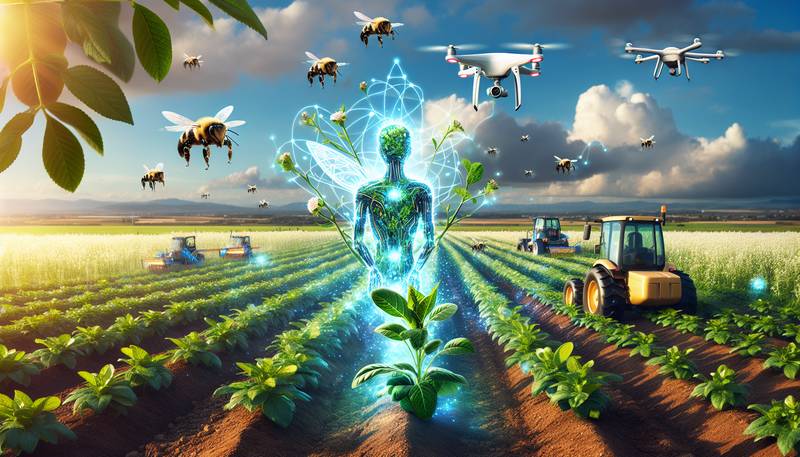AI in Agriculture: Using Biostimulants to Optimize Crop Production

Behold the Power of Artificial IntelligenceAs civilization marches towards its inevitable melting into a pool of algorithmic goo, we find ourselves entrusting our food production to the cold, calculated embrace of artificial intelligence. The agricultural landscape has been transformed from a pastoral idyll to a buzzing hive of robotic bees, whirring drones, and self-driving tractors. Among these technological marvels, biostimulants stand as a shining beacon of hope for optimizing crop yields.Biostimulants: A Love Letter to PlantsBiostimulants are not your traditional chemical fertilizers, nor are they plant-protection products. Instead, they are a glorious concoction of naturally derived substances, microorganisms, and other delectable goodies that increase plant growth and resilience. Biostimulants are the Barry White of the plant world, seducing our green friends into a frenzy of growth and reproduction.AI to the Rescue!But with great power comes great responsibility. How do we ensure that biostimulants are utilized effectively, maximizing their potential without causing undue harm? Enter artificial intelligence, our old friend and future overlord. By harnessing the power of AI, we can optimize the use of biostimulants to transform our agricultural practices into a veritable cornucopia of abundance.AI-Powered Biostimulant Optimization: A Symphony in GreenImagine a world where AI algorithms dance gracefully through fields of waving grain, carefully monitoring and analyzing plant growth. This is not a scene from a dystopian future, but rather the dawn of a new era of agricultural precision. By incorporating AI technology into biostimulant application, we can tailor treatments to the unique needs of individual plants, ensuring that each and every one of them receives the tender loving care it deserves.- Data Collection: Drones, sensors, cameras, oh my! The first step in AI-powered biostimulant optimization is gathering data on the state of the crops. Like a paparazzi flock descending upon an unsuspecting celebrity, these tools capture every detail of the plants' lives, creating a comprehensive picture of their health and wellbeing.
- Analysis: Once the data has been collected, the AI steps in to make sense of it all. By processing this information and comparing it to historical data, the AI can identify trends and make predictions about the future of the crops. This information is then used to determine the optimal biostimulant treatment plan for each individual plant.
- Application: With the data analyzed and a plan in place, AI-guided machines are dispatched to deliver the biostimulants to the plants. These machines can perform the delicate task with surgical precision, ensuring that each plant receives the exact amount of biostimulant it requires to thrive.
- Monitoring: The work doesn't end with the application of biostimulants. AI continues to monitor the crops, providing real-time feedback on their progress and adjusting the treatment plan as needed. This closed-loop system ensures that the plants are always receiving the optimal level of care.
Reaping the Rewards of AI-Aided AgricultureSo, what are the benefits of using AI to optimize biostimulant application in agriculture? As if the joy of watching our plants flourish under the watchful eye of AI isn't enough, there are myriad practical advantages to be gained from this approach:- Increased Yield: By ensuring that each plant receives the perfect amount of biostimulant, we can maximize crop yields and keep our dinner plates piled high with delectable morsels.
- Reduced Waste: By applying biostimulants with pinpoint accuracy, we can avoid wasting precious resources on areas where they are not needed. This not only saves money but also reduces the environmental impact of our agricultural practices.
- Better Quality Produce: Healthier plants produce tastier, more nutritious fruits and vegetables. By using AI to optimize biostimulant application, we can ensure that our crops are the best they can be.
- Sustainability: AI enables us to make better use of resources, reducing waste and ensuring that our agricultural practices are sustainable for generations to come.
Embrace the Future: AI, Biostimulants, and YouSo there you have it, dear cultivators of the land: a brave new world of AI-powered biostimulant optimization. By harnessing the power of artificial intelligence, we can unlock the full potential of biostimulants, revolutionizing our agricultural practices and ensuring a bountiful harvest for all. As we hurtle towards an uncertain future, one thing is for certain: AI and biostimulants are a match made in heaven, and together, they will lead us into a verdant utopia of optimized crop production.
|
|







